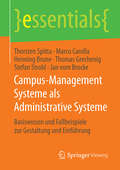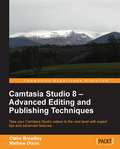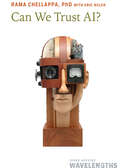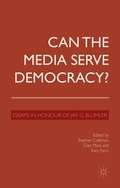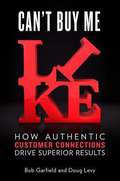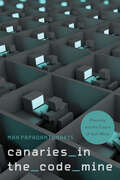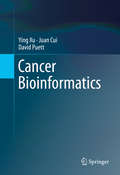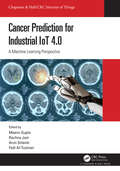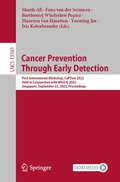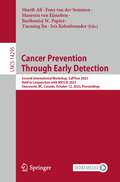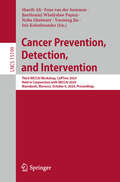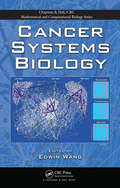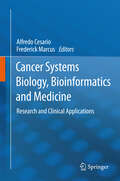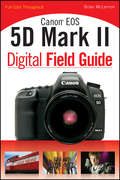- Table View
- List View
Campus-Management Systeme als Administrative Systeme: Basiswissen und Fallbeispiele zur Gestaltung und Einführung (essentials)
by Jan Vom Brocke Thorsten Spitta Marco Carolla Henning Brune Thomas Grechenig Stefan StroblDie Autoren vermitteln, was den Softwaretyp Campus-Management ausmacht, welche Funktionen zum Kern eines CMS gehören und welche nicht benötigt werden. Sie skizzieren die Datenbasis solcher Systeme in einem Referenz-Datenmodell. Vertiefend wird dieses Modell im Buch Ein Referenz-Datenmodell für Campus-Management-Systeme in deutschsprachigen Hochschulen (Carolla 2015) empirisch validiert beschrieben. Neben den Charakteristika Administrativer Systeme im Hochschulbereich illustrieren die Autoren die Einführung zweier produktiver CMS, die als Eigenentwicklungen in Bielefeld und Wien entstanden sind.
Camtasia Studio 8: Advanced Editing and Publishing Techniques
by Mathew Dixon Claire BroadleyA practical guide packed with examples that will show you how to implement the different features of Camtasia Studio 8 and create professional looking projects.If you are familiar with Camtasia Studio and you want to experiment with more advanced techniques, then this is the guide you have been looking for!
Can Animals And Machines Be Persons?: A Dialogue
by Justin Leiber"This is a dialogue about the notion of a person, of an entity that thinks and feels and acts, that counts and is accountable. Equivalently, it's about the intentional idiom --the well-knit fabric of terms that we use to characterize persons. Human beings are usually persons (a brain-dead human might be considered a human but not a person). However, there may be persons, in various senses, that are not human beings. Much recent discussion has focused on hypothetical computer-robots and on actual nonhuman great apes. The discussion here is naturalistic, which is to say that count and accountability are, at least initially, presumed to be naturally well-knit with the possession of a cognitive and affective life. " --Justin Leiber, from the Introduction
Can We Trust AI? (Johns Hopkins Wavelengths)
by Rama ChellappaArtificial intelligence is part of our daily lives. How can we address its limitations and guide its use for the benefit of communities worldwide?Artificial intelligence (AI) has evolved from an experimental computer algorithm used by academic researchers to a commercially reliable method of sifting through large sets of data that detect patterns not readily apparent through more rudimentary search tools. As a result, AI-based programs are helping doctors make more informed decisions about patient care, city planners align roads and highways to reduce traffic congestion with better efficiency, and merchants scan financial transactions to quickly flag suspicious purchases. But as AI applications grow, concerns have increased, too, including worries about applications that amplify existing biases in business practices and about the safety of self-driving vehicles. In Can We Trust AI?, Dr. Rama Chellappa, a researcher and innovator with 40 years in the field, recounts the evolution of AI, its current uses, and how it will drive industries and shape lives in the future. Leading AI researchers, thought leaders, and entrepreneurs contribute their expertise as well on how AI works, what we can expect from it, and how it can be harnessed to make our lives not only safer and more convenient but also more equitable. Can We Trust AI? is essential reading for anyone who wants to understand the potential—and pitfalls—of artificial intelligence. The book features:• an exploration of AI's origins during the post–World War II era through the computer revolution of the 1960s and 1970s, and its explosion among technology firms since 2012;• highlights of innovative ways that AI can diagnose medical conditions more quickly and accurately;• explanations of how the combination of AI and robotics is changing how we drive; and• interviews with leading AI researchers who are pushing the boundaries of AI for the world's benefit and working to make its applications safer and more just. Johns Hopkins WavelengthsIn classrooms, field stations, and laboratories in Baltimore and around the world, the Bloomberg Distinguished Professors of Johns Hopkins University are opening the boundaries of our understanding of many of the world's most complex challenges. The Johns Hopkins Wavelengths book series brings readers inside their stories, illustrating how their pioneering discoveries and innovations benefit people in their neighborhoods and across the globe in artificial intelligence, cancer research, food systems' environmental impacts, health equity, planetary science, science diplomacy, and other critical arenas of study. Through these compelling narratives, their insights will spark conversations from dorm rooms to dining rooms to boardrooms.
Can You Become a Pro Gamer?: An Interactive Adventure (You Choose: Chasing Fame and Fortune)
by Eric BraunCan you hone your virtual gaming skills enough to make you a star in the world of pro gaming? First, find your game and pick your platform. Then, set out to see if you’ve got what it takes. Make real-life choices that can lead to disappointment, a future in the gaming industry, or realizing your dream of becoming king or queen of the console.
Can You Become a Social Media Influencer?: An Interactive Adventure (You Choose: Chasing Fame and Fortune)
by Eric BraunDo you want to make social media your microphone to the world? Maybe you're a trend-setter or a social justice leader. Now is your chance to set out a path to social media domination. Face real-life choices that will help you learn about marketing, messaging, and what it takes to make it as a social media star.
Can Your Smartphone Change the World? (PopActivism #1)
by Erinne PaisleyCan Your Smartphone Change the World? is a twenty-first-century guide for anyone who has access to a smartphone. This how-to manual looks at specific ways you can create social change through the tap of a screen. Filled with examples of successful hashtag campaigns, viral videos and new socially conscious apps, the book provides practical advice for using your smartphone as a tool for social justice. This is the first book in the PopActivism series. Can Your Outfit Change the World? comes out in spring 2018 and Can Your Conversations Change the World? in fall 2018.
Can the Media Serve Democracy?
by Stephen Coleman Giles Moss Katy ParryThis landmark collection brings leading scholars in the field of political communication to debate one of the most important questions of our age: Can the media serve democracy? For the media to be democratic, they must enter into a positive relationship with their readers, viewers and listeners as citizens rather than consumers who buy things, audiences who gaze upon spectacles or isolated egos, obsessed with themselves. The media's first task is to remind people that they are inhabitants of a world in which they can make a difference. By enabling citizens to encounter and make sense of events, relationships and cultures of which they have no direct experience, the media constitute a public arena in which members of the public come together as more than passing strangers.
Can't Buy Me Like
by Bob GarfieldToday’s brands face an apparent choice between two evils: continue betting on their increasingly ineffective advertising or put blind faith in the supposedly mystical power of social media, where "likes” stand in for transactions and a mass audience is maddeningly elusive. There has to be a better way . . . As Lennon and McCartney wrote a half century ago, money can’t buy you love. But in today’s world, where people have become desensitized-even disillusioned-by ad campaigns and marketing slogans, that maxim needs an update: Money can’t even buy you like. That’s because we’ve entered the "Relationship Era,” where the only path for businesses seeking long-term success is to create authentic customer relationships. Not through hip social media promotions, viral videos or blizzards of micro-targeted online ads. Those tactics, which simply disguise old ways of thinking with new technology, just don’t work in the long run. So what does work in this bewildering new era? Where do "authentic customer relationships” come from? The answers will make some leaders sigh with relief while others rip their hair out: Honesty. Transparency. Shared values. A purpose beyond profit. Sure you still need a high-quality product or service to offer, but that’s not enough. Now that people can easily discover everything that’s ever been said about your brand, you can’t manipulate, seduce, persuade, flatter or entertain them into loyalty. You have to treat them like flesh-and-blood human beings, not abstract consumers or data points on a spreadsheet. It may sound like the woo-woo language of self-help books and inspirational wall posters. But as Garfield and Levy show in this book, it’s the deadly serious reality of business in the 2010s. It’s why General Motors abandoned its $10 million annual budget for Facebook ads, and why some brands have hurt themselves badly on social media by nagging, interrupting, abusing and generally ticking off their customers. The good news is that some companies have already embraced the Relationship Era and are enjoying consistent growth and profits while spending substantially less on marketing than their competitors. The authors show what we can learn from case studies such as . . . Patagonia, a clothing company with a passion for environmentalism, which solidified its customer relationships by urging people NOT to buy one of its jackets. Panera Bread, which doubled per-store sales by focusing on ways to create a welcoming environment while spending just 1 percent of sales on advertising. Secret, the women’s antiperspirant brand, which gained significant share by focusing on its commitment to strong women. Krispy Kreme, which has built a near cult of loyal Facebook and Twitter fans, all but obliterating the need for paid advertising. Blending powerful new research, fascinating examples and practical advice, Garfield and Levy show how any company can thrive in the Relationship Era. .
Canaries in the Code Mine: Precarity and the Future of Tech Work
by Max PapadantonakisThe idea that the tech industry is a secure field with jobs and opportunities for growth is a myth. There is widespread precarity among software developers, who experience uncertainty, anxiety, and imposter syndrome as technological advancements threaten job security. Max Papadantonakis investigates this phenomenon in his revealing study, Canaries in the Code Mine. He indicates that precarity is not just about the risk of losing one’s job; it is about living in a career where basic needs and rights are not guaranteed. Interviewing 120 software developers from leading tech firms, Papadantonakis shows how temporary contracts, project cancellations, and company downsizing undermine the security of even highly skilled professionals. He also highlights the systemic inequalities that shape the tech industry, showing how age, race, and gender often dictate the opportunities and responsibilities software developers have—or are denied. Canaries in the Code Mine highlights a disturbing reality of privilege and vulnerability within the tech industry. Papadantonakis engages in a critical discourse on the evolving nature of work in the digital era, emphasizing the need to shape an equitable future in the rapidly evolving landscape.
Cancel Culture: The Latest Attack on Free Speech and Due Process
by Alan DershowitzIn Cancel Culture, Alan Dershowitz—New York Times bestselling author and one of America&’s most respected legal scholars—makes an argument for free speech, due process, and restraint against the often overeager impulse to completely cancel individuals and institutions at the ever-changing whims of social media-driven crowds. Alan Dershowitz has been called &“one of the most prominent and consistent defenders of civil liberties in America&” by Politico and &“the nation&’s most peripatetic civil liberties lawyer and one of its most distinguished defenders of individual rights&” by Newsweek. Yet he has come under intense criticism for his steadfast and consistent championing of those same principles, and his famed &“shoe‑on‑the‑other‑foot test,&” to those who have been &“cancelled&” for any number of faults, both real and imagined. Cancel Culture is a defense of due process, free speech, and even-handedness in the application of judgment. It makes the case for restraint and care in decisions about whom and what to cancel, boycott, deplatform, and bar from public life, and offers recommendations for when, why, and to what degree these steps may be appropriate, as long as objective, fair-minded criteria can be determined and met. While Dershowitz argues against the worst excesses of cancel culture—the rush to judgment and the devastating results it can have on those who may be innocent, the power of social media to effect punishment without a thorough examination of evidence, the idea that historical events can be viewed through the same lens as actions in the present day—he also acknowledges that its defenders ostensibly try to use it to create meaningful, positive change, and notes that cancelling may itself be a constitutionally protected form of free speech. In the end, Cancel Culture represents an icon in the defense of free speech and due process reckoning with the greatest challenge and threat to these rights since the rise of McCarthyism. It is essential reading for anyone interested in or concerned about cancel culture, its effects on our society, and its significance in a greater historical and political context.
Cancer Bioinformatics
by Ying Xu Juan Cui David PuettThis book provides a framework for computational researchers studying the basics of cancer through comparative analyses of omic data. It discusses how key cancer pathways can be analyzed and discovered to derive new insights into the disease and identifies diagnostic and prognostic markers for cancer. Chapters explain the basic cancer biology and how cancer develops, including the many potential survival routes. The examination of gene-expression patterns uncovers commonalities across multiple cancers and specific characteristics of individual cancer types. The authors also treat cancer as an evolving complex system, explore future case studies, and summarize the essential online data sources. Cancer Bioinformatics is designed for practitioners and researchers working in cancer research and bioinformatics. It is also suitable as a secondary textbook for advanced-level students studying computer science, biostatistics or biomedicine.
Cancer Mortality and Morbidity Patterns in the U.S. Population: An Interdisciplinary Approach (Statistics for Biology and Health)
by Julia Kravchenko Igor Akushevich K. G. MantonThe purpose of this book is to examine the etiology of cancer in large human populations using mathematical models developed from an inter-disciplinary perspective of the population epidemiological, biodemographic, genetic and physiological basis of the mechanisms of cancer initiation and progression. In addition an investigation of how the basic mechanism of tumor initiation relates to general processes of senescence and to other major chronic diseases (e.g., heart disease and stroke) will be conducted.
Cancer Prediction for Industrial IoT 4.0: A Machine Learning Perspective (Chapman & Hall/CRC Internet of Things)
by Meenu GuptaCancer Prediction for Industrial IoT 4.0: A Machine Learning Perspective explores various cancers using Artificial Intelligence techniques. It presents the rapid advancement in the existing prediction models by applying Machine Learning techniques. Several applications of Machine Learning in different cancer prediction and treatment options are discussed, including specific ideas, tools and practices most applicable to product/service development and innovation opportunities. The wide variety of topics covered offers readers multiple perspectives on various disciplines. Features • Covers the fundamentals, history, reality and challenges of cancer • Presents concepts and analysis of different cancers in humans • Discusses Machine Learning-based deep learning and data mining concepts in the prediction of cancer • Offers real-world examples of cancer prediction • Reviews strategies and tools used in cancer prediction • Explores the future prospects in cancer prediction and treatment Readers will learn the fundamental concepts and analysis of cancer prediction and treatment, including how to apply emerging technologies such as Machine Learning into practice to tackle challenges in domains/fields of cancer with real-world scenarios. Hands-on chapters contributed by academicians and other professionals from reputed organizations provide and describe frameworks, applications, best practices and case studies on emerging cancer treatment and predictions. This book will be a vital resource to graduate students, data scientists, Machine Learning researchers, medical professionals and analytics managers.
Cancer Prevention Through Early Detection: First International Workshop, CaPTion 2022, Held in Conjunction with MICCAI 2022, Singapore, September 22, 2022, Proceedings (Lecture Notes in Computer Science #13581)
by Sharib Ali Fons van der Sommen Bartłomiej Władysław Papież Maureen Van Eijnatten Yueming Jin Iris KolenbranderThis book constitutes the refereed proceedings of the first International Workshop on Cancer Prevention through Early Detection, CaPTion, held in conjunction with the 25th International Conference on Medical Imaging and Computer-Assisted Intervention, MICCAI 2022, in Singapore, Singapore, in September 2022. The 16 papers presented at CaPTion 2022 were carefully reviewed and selected from 21 submissions. The workshop invites researchers to submit their work in the field of medical imaging around the central theme of early cancer detection, and it strives to address the challenges that are required to be overcomed to translate computational methods to clinical practice through well designed, generalizable (robust), interpretable and clinically transferable methods.
Cancer Prevention Through Early Detection: Second International Workshop, CaPTion 2023, Held in Conjunction with MICCAI 2023, Vancouver, BC, Canada, October 12, 2023, Proceedings (Lecture Notes in Computer Science #14295)
by Bartłomiej W. Papież Sharib Ali Fons van der Sommen Maureen Van Eijnatten Yueming Jin Iris KolenbranderThis book constitutes the refereed proceedings of the second International Workshop on Cancer Prevention through Early Detection, CaPTion, held in conjunction with the 26th International Conference on Medical Imaging and Computer-Assisted Intervention, MICCAI 2023, in Vancouver, Canada, in October 2023.The 11 papers presented at CaPTion 2023 were carefully reviewed and selected from 12 submissions. The workshop invites researchers to submit their work in the field of medical image analysis around the central theme of cancer and early cancer detection, progression, inflammation understanding, multimodality data, and computer-aided navigation.
Cancer Prevention, Detection, and Intervention: Third MICCAI Workshop, CaPTion 2024, Held in Conjunction with MICCAI 2024, Marrakesh, Morocco, October 6, 2024, Proceedings (Lecture Notes in Computer Science #15199)
by Sharib Ali Fons van der Sommen Bartłomiej Władysław Papież Yueming Jin Iris Kolenbrander Noha GhatwaryThis book constitutes the refereed proceedings of the Third International Workshop on Cancer Prevention Through Early Detection, CaPTion, held in conjunction with the 27th International Conference on Medical Imaging and Computer-Assisted Intervention, MICCAI 2024, in Marrakesh, Morocco, on October 6, 2024. The 22 full papers presented in this book were carefully reviewed and selected from 25 submissions. They were organized in topical sections as follows: Classification and characterization; detection and segmentation; cancer/early cancer detection, treatment and survival prognosis.
Cancer Systems Biology (Chapman & Hall/CRC Computational Biology Series)
by Edwin WangThe unprecedented amount of data produced with high-throughput experimentation forces biologists to employ mathematical representation and computation to glean meaningful information in systems-level biology. Applying this approach to the underlying molecular mechanisms of tumorgenesis, cancer research is enjoying a series of new discoveries and biological insights. Unique in its dualistic approach, this book introduces the concepts and theories of systems biology and their applications in cancer research. It presents basic cancer biology and cutting-edge topics of cancer research for computational biologists alongside systems biology analysis tools for experimental biologists.
Cancer Systems Biology, Bioinformatics and Medicine: Research and Clinical Applications
by Frederick Marcus Alfredo CesarioThis teaching monograph on systems approaches to cancer research and clinical applications provides a unique synthesis, by world-class scientists and doctors, of laboratory, computational, and clinical methods, thereby establishing the foundations for major advances not possible with current methods. Specifically, the book: 1) Sets the stage by describing the basis of systems biology and bioinformatics approaches, and the clinical background of cancer in a systems context; 2) Summarizes the laboratory, clinical, data systems analysis and bioinformatics tools, along with infrastructure and resources required; 3) Demonstrates the application of these tools to cancer research; 4) Extends these tools and methods to clinical diagnosis, drug development and treatment applications; and 5) Finishes by exploring longer term perspectives and providing conclusions. This book reviews the state-of-the-art, and goes beyond into new applications. It is written and highly referenced as a textbook and practical guide aimed at students, academics, doctors, clinicians, industrialists and managers in cancer research and therapeutic applications. Ideally, it will set the stage for integration of available knowledge to optimize communication between basic and clinical researchers involved in the ultimate fight against cancer, whatever the field of specific interest, whatever the area of activity within translational research.
Candidate Hillary: From Senator to Presidential Hopeful
by Beth J. Harpaz The Associated PressHillary is up in the polls! Hillary is down in the polls! She&’s a feminist and women love her; she&’s an enabler and women hate her. She&’s brilliant and hardworking; she&’s entitled and untrustworthy. Sounds like Hillary Rodham Clinton&’s 2016 or even 2008 presidential campaign, right? Well, go back even farther to the year 2000 to discover how every one of those phrases was uttered during Hillary&’s very first campaign when she made history as the only first lady to ever run for office. That groundbreaking bid for U.S. Senate in New York made headlines around the world, coming as it did on the heels of her husband&’s scandalous affair with a White House intern. Reporter Beth J. Harpaz was there, covering this political whirlwind for The Associated Press, and her book, "Candidate Hillary," previously published as "The Girls in the Van," revisits every key moment of the race. This funny, fascinating account puts you in the press van that followed Hillary from Buffalo to Brooklyn as she fought a cast of familiar characters, including New York&’s pugnacious Mayor Rudy Giuliani. It&’s filled with all the successes and missteps, the kind that plagued the assumed front-runner&’s 2008 campaign for the Democratic presidential nomination, which instead went to a young Senator from Illinois named Barack Obama. Now, updated with new perspectives from the author and an introduction by National Politics Reporter Lisa Lerer, "Candidate Hillary" offers a window into Hillary&’s vulnerabilities, strengths and the inner workings of the Clinton machine, all told with authority, humor and the benefit of hindsight.
Candy Crush Jelly Saga - Guida non ufficiale
by Hiddenstuff Entertainment Giulia RoasioSconfiggi i livelli, conquista bonus e punteggi record *guida non ufficiale* Allegato all'acquisto di questo eBook potrai registrarti per un programma supplementare di guide gratuite. copiando il link qui sotto avrai accesso agli ultimi update per le app ed i giochi più poplari. registrati grati qui sotto http://emailsignupform.subscribemenow.com/ Suggerimenti avanzati e guida strategica. questa è la più completa e dettagliata guida che puoi trovare online, disponibile come download per cellulari, dispositivi eBook, o in formato cartaceo. Con il successo delle mie altre centinaia di guide scritte e strategie, ho scritto un altra guida avanzata e professionale per i nuovi giocatori ed i veterani. Questa offre specifiche strategie e consigli su come progradire nel gioco, sconfiggere gli avversari, acquisire più monete e denaro, e molto altro. Qui è quello che avrai con l'acquisto di questa guida di gioco professionale ed avanzata - Consigli e strategie professionali. - Suggerimenti e hack - Segreti, consigli, trucchi, sblocchi, e trucchi usati dai giocatori pro! - Come avere tonnellate di denaro. - E MOLTO ALTRO! Tutte le versioni di questa guida includono immagini per meglio comprendere il gioco. Non esistono altre guide che siano altrettanto comprensive e avanzate quanto questa. Sarai felice di aver acquistato questa guida e ne avrai benefici molto maggiori se comparati con altre guide in circolazione meno efficaci. Acquista ora e distruggi gli avversari! diventa un giocatore pro oggi stesso! Per supporto e altre informazioni sui nostri prodotti visita: http://www.hiddenstuffentertainment.com/ Disclaimer: Questo prodotto non è associato, affiliato, appoggiato, certificato o sponsorizzato dal possessore del copyright originale. Tutti i marchi sono registrati, i marchi che appaiono in questo eBook sono di proprietà dei rispettivi proprietari.
Candy Crush Soda Saga Guida di Gioco non Ufficiale
by Valeria Ciccotti Joshua AbbottSuperate i livelli, ottenete tutti i potenziamenti e i punteggi più alti! Con la mia guida completa per Candy Crush Soda Saga apprenderete proprio tutto sul gioco! Le strategie descritte in questa guida sono note solo ai giocatori più esperti. La mia guida illustra tutto questo: - Panoramica e informazioni di base su Candy Crush Saga - Oggetti utili/combinazioni e ciò che fanno - Come ottenere più vite - Le migliori combinazioni di caramelle per superare i livelli e ottenere punteggi - Strategie per ogni tipo di livello. Come superare TUTTI i livelli! - Segreti, suggerimenti e trucchi usati dai giocatori professionisti! - Istruzioni dettagliate passo dopo passo - Strategie e dinamiche generali di gioco - Ed in più molto altro! Acquistate ora per non rimanere più bloccati mentre tentate di superare un livello, oppure senza vite! Diventate giocatori professionisti oggi! Disclaimer: Questo prodotto non è associato, affiliato, sostenuto o sponsorizzato da King o Midasplayer.com Limited, e non sono stati effettuati test, recensioni o certificazioni. Questa guida va usata come riferimento. Questo prodotto non modifica il gioco in alcun modo. Questa è una guida scritta e non è un programma software.
Candy Hearts
by Tommy SiegelThe acclaimed comic strip artist presents a hysterically honest, unnervingly accurate window into the minds of romantic partners. Tommy Siegel&’s Candy Heats comics became an internet sensation drawing a global fanbase that included cultural luminaries from Ringo Starr to Alexandria Ocasio-Cortez. From the awkwardness of flirting during a pandemic to scrolling through disastrous dating profiles, Candy Hearts hilariously captures the secrets, lies, and misunderstandings behind every relationship. With dozens of never-before-seen comics, this book is the perfect Valentine&’s Day (or Anti-Valentine&’s Day) gift for your friends, lovers, and especially yourself.
Canon EOS 5D Mark II Digital Field Guide
by Brian MclernonEasy-to-understand techniques for getting the most from your Canon EOS 5D Mark II DSLRAt nearly $3,000 for the body only, the Canon 5D Mark II DSLR is for amateurs and semi-professionals who are serious about taking great photos-and this go-anywhere guide shares insight for doing just that. Authors Charlotte Lowrie and Brian McLernon walk you step by step through each function on the Canon EOS 5D Mark II, going into more depth and scope than the standard manual that accompanies the camera.Portable and easy to understand, the book shows you how to get the exact show you want, when you want them, and is packed with more than 200 beautiful color photos.Includes step-by-step techniques and professional tips on taking exceptional photos with your Canon EOS 5D Mark IIReviews how to better understand the various functions and potential of your Canon EOS 5D Mark IIFeatures samples of inspirational photos taken by the authorWith so much helpful advice for getting the most out of your Canon EOS 5D Mark II, you'll be referencing this guide again and again.
